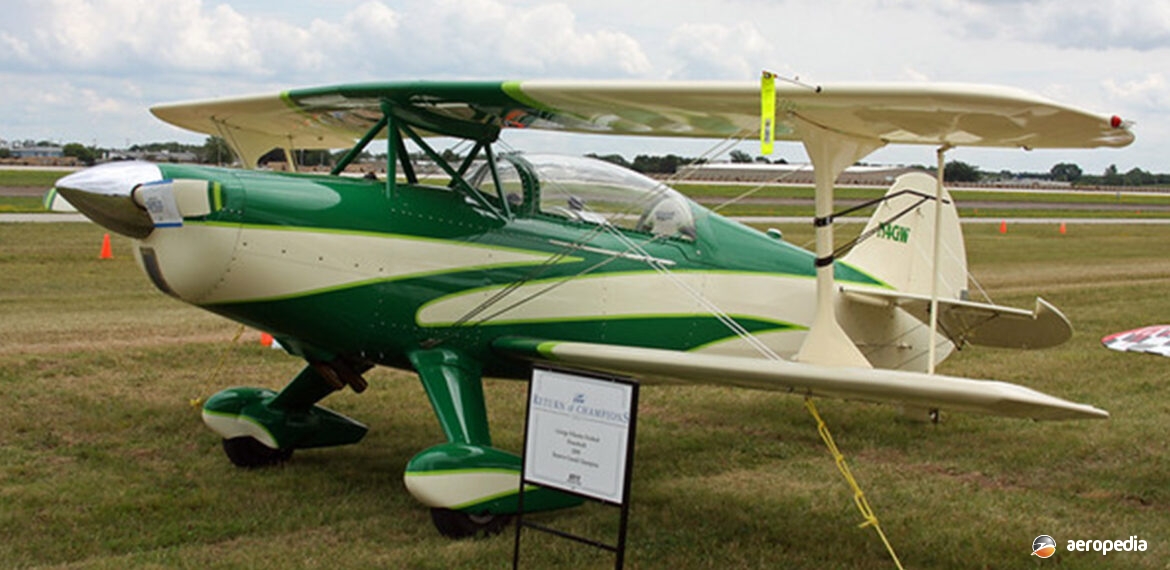Photograph:
Starfire Firebolt N4GW (c/n 90) attending Oshkosh, Wisconsin in 2013 (Author’s collection)
Country of origin:
United States of America
Description:
Two-seat aerobatic sport biplane
Power Plant:
One 224 kw (300 hp) Lycoming IO-540 six-cylinder horizontally-opposed air-cooled engine
Specifications:
- Wingspan: 7.32 m (24 ft 0 in)
- Length: 6.48 m (21 ft 3 in)
- Height: 2.31 m (7 ft 7 in)
- Wing area: 13.94 m² (150.00 sq ft)
- Max speed: 378 km/h (235 mph)
- Cruising speed: 325 km/h (202 mph)
- Stalling speed: 100 km/h (62 mph)
- Service ceiling: 5,486 m (18,000 ft)
- Rate of climb: 1,219 m/min (4000 ft/min)
- Range: 805 km (500 miles)
- Take-off distance: 122 m (400 ft)
- Landing distance: 244 m (800 ft)
- Fuel capacity: 147 litres (32 Imp gals)
- Empty weight: 601 kg (1,325 lb)
- Useful load: 306 kg (675 lb)
- Loaded weight: 907 kg (2,000 lb)
History:
The Starfire Firebolt, a two-seat high-performance aerobatic biplane, also known as the Starfire Firebolt Convertible [convertible because the cockpit canopy could be quickly removed] and the MacKenzie Skybolt, was designed by G H McKenzie and was produced by Starfire Aviation of Tempe, Arizona. It was produced in small numbers, nine examples appearing on the American Civil Register at one time. It was a development of the Steen Skybolt and was made available in plan form from 1998 for amateur construction, some prefabricated parts being made available.
The Steen Skybolt was designed by Lamar Steen and marketed in the 1970s, the Company Steen Aero Lab being set up to offer plans and components. It became the most constructed two-seat experimental aircraft of the time. In the 1990s Hale Wallace obtained the Steen Aero company and, in addition to offering plans and components for the Skybolt, the rights to the Pitts S-1C were obtained, these being updated to the Pitts S-1SS. Rights were then obtained to the Knight Twister series, which had been designed by Vernon Payne. The Company also distributed Bruntons brace wires and Hoffman propellers in North America.
After Mr Hale passed away, Paul Goetsch and Jere Larson took over the Company and developed CNC manufacturing capability to manufacture aircraft parts. A facility was set up in Palm Bay, Florida. Steen Aero then obtained the rights to what had become known as the MacKenzie Firebolt variant of the Skybolt as well as the experimental variant of the Great Lakes Biplane. The Skybolt was then developed with a three section wing and a hydraulic undercarriage, and a variant known as the Skybolt Radial was released fitted with the 269 kw (360 hp) Russian-designed nine-cylinder M-14P radial engine, these model enhancements being designed by Curtis Pitts.
The Firebolt aircraft, like the Skybolt, had a biplane layout, interplane struts, cabane struts and flying wires, and seated two in tandem. Standard engine installation was the 224 kw (300 hp) Lycoming IO-540 engine. The aircraft was fitted with a tailwheel undercarriage. It was of welded steel tube construction, aluminium and wooden structure, with fabric covering. Engines in the 134 to 224 kw (180 to 300 hp) range have been fitted.
At least one aircraft in this series, registered as a MacKenzie Skybolt, was built from plans in Australia. This aircraft was registered to its owner on 26 August 2003 as VH-NKD² (c/n 64) but the registration was revoked by the Civil Aviation Authority on 6 July 2006 and the ultimate fate of the aircraft is not known.

